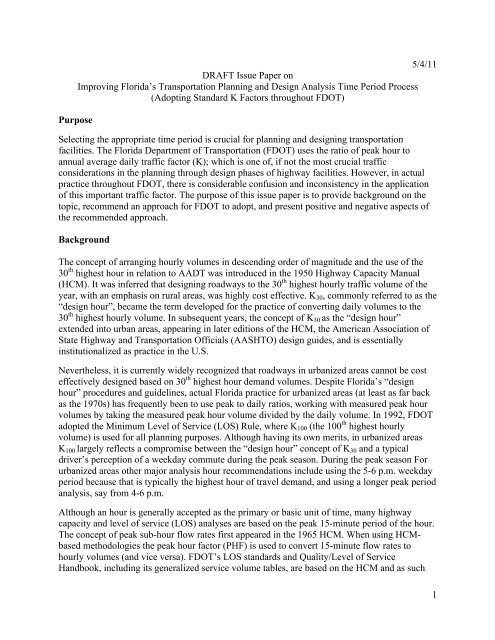Adopting Standard K Factors Throughout FDOT - FACERS
Adopting Standard K Factors Throughout FDOT - FACERS
Adopting Standard K Factors Throughout FDOT - FACERS
You also want an ePaper? Increase the reach of your titles
YUMPU automatically turns print PDFs into web optimized ePapers that Google loves.
5/4/11DRAFT Issue Paper onImproving Florida’s Transportation Planning and Design Analysis Time Period Process(<strong>Adopting</strong> <strong>Standard</strong> K <strong>Factors</strong> throughout <strong>FDOT</strong>)PurposeSelecting the appropriate time period is crucial for planning and designing transportationfacilities. The Florida Department of Transportation (<strong>FDOT</strong>) uses the ratio of peak hour toannual average daily traffic factor (K); which is one of, if not the most crucial trafficconsiderations in the planning through design phases of highway facilities. However, in actualpractice throughout <strong>FDOT</strong>, there is considerable confusion and inconsistency in the applicationof this important traffic factor. The purpose of this issue paper is to provide background on thetopic, recommend an approach for <strong>FDOT</strong> to adopt, and present positive and negative aspects ofthe recommended approach.BackgroundThe concept of arranging hourly volumes in descending order of magnitude and the use of the30 th highest hour in relation to AADT was introduced in the 1950 Highway Capacity Manual(HCM). It was inferred that designing roadways to the 30 th highest hourly traffic volume of theyear, with an emphasis on rural areas, was highly cost effective. K 30 , commonly referred to as the“design hour”, became the term developed for the practice of converting daily volumes to the30 th highest hourly volume. In subsequent years, the concept of K 30 as the “design hour”extended into urban areas, appearing in later editions of the HCM, the American Association ofState Highway and Transportation Officials (AASHTO) design guides, and is essentiallyinstitutionalized as practice in the U.S.Nevertheless, it is currently widely recognized that roadways in urbanized areas cannot be costeffectively designed based on 30 th highest hour demand volumes. Despite Florida’s “designhour” procedures and guidelines, actual Florida practice for urbanized areas (at least as far backas the 1970s) has frequently been to use peak to daily ratios, working with measured peak hourvolumes by taking the measured peak hour volume divided by the daily volume. In 1992, <strong>FDOT</strong>adopted the Minimum Level of Service (LOS) Rule, where K 100 (the 100 th highest hourlyvolume) is used for all planning purposes. Although having its own merits, in urbanized areasK 100 largely reflects a compromise between the “design hour” concept of K 30 and a typicaldriver’s perception of a weekday commute during the peak season. During the peak season Forurbanized areas other major analysis hour recommendations include using the 5-6 p.m. weekdayperiod because that is typically the highest hour of travel demand, and using a longer peak periodanalysis, say from 4-6 p.m.Although an hour is generally accepted as the primary or basic unit of time, many highwaycapacity and level of service (LOS) analyses are based on the peak 15-minute period of the hour.The concept of peak sub-hour flow rates first appeared in the 1965 HCM. When using HCMbasedmethodologies the peak hour factor (PHF) is used to convert 15-minute flow rates tohourly volumes (and vice versa). <strong>FDOT</strong>’s LOS standards and Quality/Level of ServiceHandbook, including its generalized service volume tables, are based on the HCM and as such1
use the peak 15-minute period of the hour as their analysis time period, not the full hour.Noteworthy, most other technical documents and procedures do not use the 15-minute timeperiod for analyses. For example, AASHTO’s design guides never adopted the 15-minute timeperiod as relevant for analysis within the “design hour”. Thus, there are differences as to whetherplanning and design of facilities is based on the peak 15-minute period of the hour or the averagetraffic conditions throughout the hour.Further complicating the use of K factors is the relationship between demand traffic volumes andmeasured traffic volumes. During peak travel hours, many Florida roadways are oversaturated orconstrained with travel demand exceeding capacity. Recent editions of the HCM make it cleardemand volumes should be used instead of measured volumes. Yet, all traffic counts andreported traffic statistics, including K factors, are in terms of measured volumes. Using measuredK factors for oversaturated roadways distorts how roadways should be planned and designed.Measured volumes simply cannot exceed a roadway’s capacity even during peak hours, and assuch, no roadway would be considered over capacity. Especially problematic is thedetermination of appropriate K factors in urbanized areas.Effects of the above considerations result in confusion and inconsistencies in application of Kfactors. Furthermore, because of significant cost implications both to <strong>FDOT</strong> and other entities,extensive time and effort are frequently devoted to determining an agreed upon K factor forprojects. Use of predetermined, context sensitive standard K factors combined with level ofservice standards also can have land use planning and economic development impacts includingencouraging future growth in existing developed areas and promoting efficient economic growth.Recommended Approach<strong>FDOT</strong> should adopt a “design” approach in which K factors are predetermined for the planningthrough design phases of transportation facilities. Rather than being a variable, K should becomea fixed, cost effective parameter much like the use of 12-foot through lanes is on major highspeedroadways. “<strong>Standard</strong> K” is <strong>FDOT</strong>’s term for fixed K parameters. The selected standard Kfactors should represent a full hour of analysis, not sub-hourly analyses, and reflect urbandevelopment patterns and economic development considerations. <strong>FDOT</strong>’s recommendedstandard K factors appear in Table 1. Note there is not a single standard K factor to be applied toevery roadway in the state; rather there are multiple standard K factors depending upon the areatype and facility type.It is anticipated these factors would be applied to 95% of all roadway facilities. Routine relianceon traffic studies and/or site counts for determining K factors in planning and design would beminimized. <strong>Factors</strong> would be set primarily by the area where roadways are located. For example,the K factor for roadways in most urbanized areas would simply be set at 9.0%. The standard Kfactors in Table 1 would not be applicable for the planning/design/operation of toll ways(Turnpike), or for freeway managed lanes.2
<strong>Standard</strong> K factors initially should be used for analyses of points (signalized intersections,interchange ramp terminals). However, design and operational engineers have the flexibility todesign these points as appropriate. To a large extent, the factors determined from the standard Kprocess should be viewed as approach volumes to these points. Point analyses frequently involvebalancing traffic flows and ensuring appropriate operational performance. For example, althoughit is appropriate for planning and preliminary engineering analyses to generally exclude subhourlytraffic flow considerations (setting the PHF = 1.0), it is appropriate to use a lower PHF foroperational analyses at points where capacity constraints may exist. In the design of left turnbays at signalized intersections or interchange ramp terminals, it would be appropriate toconsider peak 15-minute flows if left turning vehicles may back up into through lanes, oroperational concerns exist about vehicles backing up on freeway ramps/mainlines, respectively.The scope of current on-site project traffic and traffic impact studies would likely be decreaseddue to standard K factors. <strong>FDOT</strong>’s intention is to have the applicable standard K factor for everyroadway segment appear on its Florida Traffic and Highway Data Online Tool and related DVD.The Online Tool and DVD will include a calculated directional distribution factor (D). AssumingD factor is used, the primary purpose of an on-site traffic engineering study is for turning3
movement analyses at points (signalized intersections).Using such an approach providesstatewide consistency at a minimum cost to <strong>FDOT</strong> and outside personnel.Special considerations exist in urban and urbanized areas; both are addressed in the footnotes ofTable 1. In the state’s largest urbanized areas, <strong>FDOT</strong> would designate “core” freeways; major,non-toll freeways going into/through the urbanized core areas (I-4 in the Orlando area). As thesefreeways pass through an urbanized area, the standard K factors range from 8.0% to 9.0%,depending upon proximity to the central core or central business district. <strong>FDOT</strong> district officeswould take the lead on designating factors for the freeways. Final factors would be approved bythe <strong>FDOT</strong> Secretary and FHWA. <strong>Standard</strong> K factors for these freeways would be initially set,not on a project by project basis, and typically updated decennially as part of the urban/urbanizedarea boundary process. Recognizing the desires for future growth in existing developed areas andmultimodal solutions, <strong>FDOT</strong> will also accept and promote lower K factors for non-freeways inwhich transportation infrastructure is adequately addressed. A 7.5% K factor becomes applicablefor state arterials and highways in approved Multimodal Transportation Districts, wheresecondary priority is given to auto vehicle movements. Essentially, this lower factor representsthe promotion of a multi-hour peak period rather than a single peak hour analysis.Implementation of standard K factors on new projects or analyses would become effectiveimmediately upon approval by the Secretary of the Florida Department of Transportation.However, prior actions or approvals could remain in effect. For instance, if during the ProjectDevelopment and Environment phase where location and conceptual design approval has beengranted, the analysis based on a previous K factor could remain in effect throughout projectimplementation.<strong>Standard</strong> K factors should be reevaluated within the initial 3 years of implementation.Pilot Program Implementing <strong>Standard</strong> K <strong>Factors</strong>Before implementing a dramatically different approach for traffic analysis, <strong>FDOT</strong> seniormanagement sought actual testing of the concept. The most significant testing of the standard Kfactor approach was a one-year pilot study by <strong>FDOT</strong> District 4 which implemented standard Kfactors to be used for all traffic analyses in district activities. From 2009 to 2010, twenty-six roadimprovement projects and/or studies were included in the pilot program.Five criteria were used to evaluate the use of standard K factors: K factor comparison (standard K factors compare with K 30 values); Project traffic time comparison (estimated time savings); Project traffic cost comparison (estimated cost savings); Project traffic complexity comparison (qualitative comparison of the two methods); and Comments and feedback regarding use of standard K factors.Conclusions and recommendations from the pilot study follow: Using standard K factors for traffic forecasting at a planning level or ProjectDevelopment and Environment study level is beneficial, as it can reduce the complexityand time needed to develop traffic forecasts;4
<strong>Standard</strong> K factors are appropriate for efficiently determining the design hourly trafficvolumes for a roadway and consequent planning for the number of through lanes neededfor the roadway; andFor this purpose, permanent implementation of standard K factors is recommended.Service Volume Implications<strong>FDOT</strong>’s recommended standard K factors were developed with the intent to simultaneouslyupdate its LOS standards, LOS software (LOSPLAN) and LOS roadway, traffic andsignalization input values. Table 2 contains a preliminary comparison of planning levelmaximum service volumes for a broad range of typical state roads using the recommendedstandard K factors and other LOS updates. Those service volumes represent the maximumvolume of vehicles a roadway could generally handle at a given LOS. The table should help givereviewers a feel for the combined effect of the recommended standard K factors and other LOSupdates.<strong>Standard</strong> K factors could be implemented without updates to <strong>FDOT</strong>’s LOS standards. Table 3contains a preliminary comparison of planning level maximum service volumes for a broadrange of typical state roads using the recommended K factors and without updating the LOSstandards and other LOS updates. However, some adjustments to the recommended <strong>Standard</strong> Kfactors might be made if the standards cannot be updated in 2012.5
Positive Aspects of the Recommended ApproachThere are numerous highly constructive aspects to the recommended standard K factor approach.For one, it promotes better transportation policies and projects by leading to more cost effectiveplans and designs. In doing so, this practice can better support future growth in existingdeveloped areas to focus more on multimodal solutions. In addition, the practice ofpredetermining K factors reduces time and effort spent developing K factors and gettingapproval for individual K factors for every project. This translates into time and cost savingsthrough improved production times. It also means project development can proceed withoutwaiting on an uncertain and sometimes contested variable; thus freeing up time and resources forplanners/designers to better address travelers’ needs and focus on operational improvements.Another positive aspect to the standard K factor approach is consistency. <strong>FDOT</strong> planningthrough design staff understand what number is to be used and avoids duplication of effortand/or development of multiple and inconsistent traffic projections at different project levels.This approach provides a reliable standard avoiding significant debate and circumvents paperexercises to justify numbers. The recommended approach is also simple to understand and doesnot involve multiple calculation processes or assumptions to determine K factors. In addition, theprocess itself does not imply false precision (i.e., showing 0.01% K factor differences whenforecasted volumes may frequently vary by at least 10%).<strong>FDOT</strong> discussed the recommended standard K factor approach with its districts, offices andstatewide task teams. Initial support was shown from all affected <strong>FDOT</strong> offices. Many plannersand engineers agreed that it is a sensible approach, and that it is generally positive fordevelopment interests as well, especially in urbanized areas. Most of the recommended standardK factors are lower than the minimum K factors being used today in urban areas and specialtransportation districts where roadways are constrained. Through better planning and design, itpromotes more efficient economic growth and job creation. The approach is supportive ofgrowth management concepts as well, and there is no added cost to the Department or taxpayersto implement a standard K factor approach.Negative Aspects of the Recommended ApproachConcerns and cautions have been expressed with regards to the recommended standard Kapproach primarily because it is not current practice. Implementation would involve additionaltime and effort considering it does not match any existing state or national K procedure; thus,modifications would be essential. In Florida, revisions will be required for multiple <strong>FDOT</strong>guidance, procedures, rules and technical tools.<strong>Adopting</strong> standard K factors represents an acceptance of greater motor vehicle congestion inurbanized areas and current reported deficiencies will decrease. The standard K factor approachdownplays the historical role of traffic engineering in gathering traffic data for project specificanalyses. Furthermore, traffic variations in K are not sensitive to peculiarities of a roadway withconsideration to orientation (e.g., circumferential vs. radial) and nearby land use or locationwithin an area type (e.g., transit-oriented design densities).7
Adoption of standard K factors may create differences with current agreements among <strong>FDOT</strong>,local governments and developers. There would be timing issues regarding phasing in the newapproach and project priorities could change. There would need to be a way to deal with the fairtreatment of “grandfathered in” projects, an developer “fair share” contributions may dropappreciably in urbanized areas,.As with any new major change, there is uncertainty about what problems might occur withimplementation of the standard K factor approach. Significant outreach would be essential forgeneral acceptance.8











